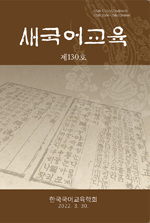이 연구는 형용사 반복 구성의 양상과 어휘 분포, 의미적 특징을 살펴보았다. 형용사 반복 구성은 형용사의 어간에 ‘-디’, ‘-(으)나’, ‘-고’가 연결되어 이루어지며, 이 때 강조의 의미를 수반한다. 반복 구성의 전형적인 유형은 ‘-디’에 의한 구성이다. ‘-디’에 의한 형용사 반복 구성은 주로 관형형의 쓰임이 생산적이며 ‘아주, 매우, 가장, 퍽’ 등과 같은 적극적인 정도 부사와의 호응이 자연스럽다. 또한 ‘-디’는 동일한 형용사의 반복에서만 쓰이며 주로 시각 경험과 관련된 감각어와의 쓰임이 자연스럽다. 이 때 복합적 의미를 지닌 어간과의 결합에 있어서는 제약이 따른다. 이러한 형용사 반복 구성의 제약은 ‘-디’의 의미 특징에 따른 것으로 ‘-디’는 경험주가 대상의 상태나 성질을 최상위로 판단하는 의미 기능을 갖는다. 그 의미는 정도 부사 ‘가장’과 유사하다. 곧 ‘-디’에 의한 반복 구성은 대상과 그 대상의 상태나 성질의 정도성을 가장 최상위로 끌어올리는 의미 특성이 있다.
The purpose of this study is to make clear the form and the meaning of the adjective repetition construction in Korean. The stem of an adjective is repeated and is connected by either ‘-디’, ‘-(으)나’, or ‘-고’ in the adjective repetition construction. These constructions are often applied to adjectives of sens terms and have emphasis meaning. We surveyed the ‘-디’ construction is the most typical adjective repetition construction. The ‘-디’ is connective ending, it is only connected with the same adjectives. This repetition construction mainly is applied to the sensitive adjective and the single adjective meaning. Especially the ‘-디’ construction emphasizes the object and of which condition to the highest degree. This point is meaning feature of ‘-디’. Also, this is the cause of difference between ‘-디’ and ‘-(으)나’ construction. The ‘-디’ is connective ending and its meaning is very similar to the meaning of the adverb ‘가장’ in adjective repetition construction.
1. 서론
2. 반복 구성의 양상
3. 반복 구성의 어휘 분포와 의미
4. 결론
(0)
(0)
